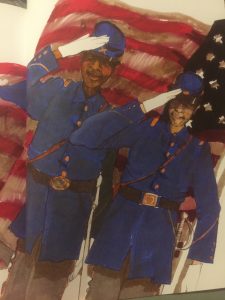
Title: Pink and Say
Author and Illustrator: Patricia Polacco
Publisher and Year: Babushka Inc. 1994
Number of Pages: 44
Tags: Non-fiction, 4-5, 6-8, Friendship, Stephanie Rudi
Genres: Non-fiction
Analysis:
A white Yankee soldier named Say, is found badly wounded in a field by a Yankee African American boy known as Pink. Pink takes say to his master’s old house to help him recover. Say learns that Pink and his family are all slaves, and his master left with everyone but his mother. During this time, Say teaches Pink how to read. Say empathizes with Pink, but doesn’t understand why he wants to go back to the war. Pink tells Say that the war is a fight for the freedom of his people, and he would do anything to help end slavery. In the end, confederate soldiers come and kill Pink’s mother, while capturing Pink and Say. The boys are split up at the camp, and Say survives, but Pink is killed almost immediately.
I think that this story is a door into the emotional time of Civil War and slavery. I feel that the openness of the illustrations and text invite the reader to be involved. Perceptually, we see two boys of different skin colors fighting in a war together and getting separated. They end up caring for each other and it is very sad when they are separated at the camp. Structurally, the characters are represented differently but also the same. They fight on the same side, but as different races fighting towards a common good. Pink and Say are united against the force of evil, which ultimately brings them together, but also separates them in the end.
In an ideological sense, we see that the Civil War divides the boys by race, because one is a slave who is killed immediately after being captured, while the other is white and gets to survive. The culture is one that treats African Americans as slaves and doesn’t even let them fight with guns like the white soldiers. Historically, the two boys should have never associated, but a near death experience brings them together to understand each other which is symbolic for how all humans live and die, and the belief that we shouldn’t let race divide us.
The picture book codes show us are interesting because of the time the African American boy is above the white boy which generally means he has more power over him, which he technically does since the white boy is injured. This plays on our expectations of the way this genre of nonfiction is represented, since usually a story about race in this time period would show the white boy as being more powerful. The illustrations are enjoyable to look at because they look authentic since they appear to be hand drawn and water painted. This media makes the story appear more realistically and creates a sort of relatability and rawness. The author’s note of this work is very interesting because she tells us that it is a story passed down from generation to generation and this makes it more believable and personal.

